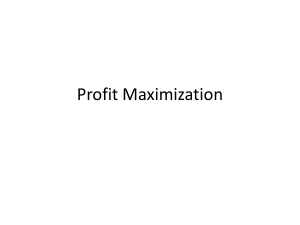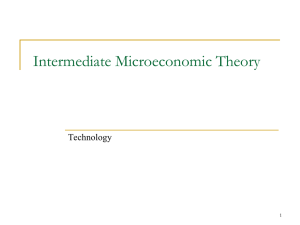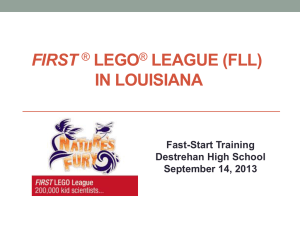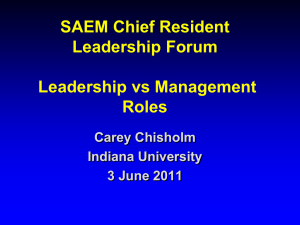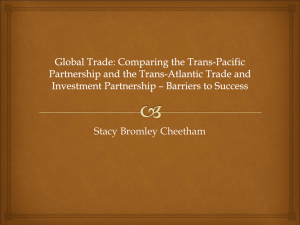L08_Cost_Minimization_2015
advertisement
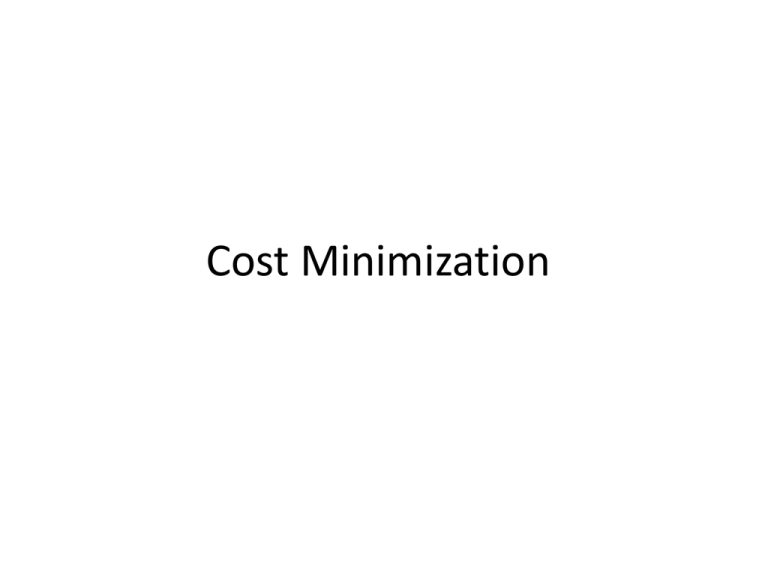
Cost Minimization Accountants vs. Economists • Economists think of costs differently from accountants. – Economics Cost = Explicit Costs + Implicit Costs – Accounting Cost = Explicit Costs – Opportunity Cost is synonymous with Cost – Measuring implicit opportunity costs is difficult • generally, these are resources “owned” by the firm • Includes the value of the entrepreneur’s time • Includes accounting profit at next best alternative use of firm’s resources – or, accounting profit from selling all owned resources and investing the proceeds in the best possible alternative investment. Fixed Cost and Sunk Cost • Fixed vs. Sunk cost – “fixed” means its cost does not vary with output – “sunk” means its cost cannot be avoided • The security guard outside the parking lot is a fixed cost, but if they can be fired at a moment’s notice, the cost is not sunk • A long term lease for renting a building is fixed and sunk – Varian calls a fixed cost that is not sunk a “quasifixed cost” – Sunk, but not fixed? No, because if it varies, it can be avoided. Short Run – Long Run • Key distinction in terms of optimizing behavior if everything can be controlled vs. not everything can be controlled. • Short run, the quantities of some inputs used in production are fixed and some are variable. – Short run, firms can shut down (q=0), but cannot exit the industry • Long run, the quantity of all inputs used are variable. – Long run, firms can enter or exit an industry. To Distinguish Short Run from Long Run • We need two inputs, one always variable, and one that can only be adjusted periodically, but is then re-fixed. • To accomplish that, we assume two inputs • Homogeneous labor (L), measured in labor per time • Homogeneous capital (K), measured in machine per time • Entrepreneurial costs assumed to be zero (or included in fixed costs) • Inputs are hired in perfectly competitive markets, so price of L, w, and price of K, v, are not a function of L and K To be clear • L is assumed always variable • K is always fixed when the firm is in production, but can periodically be adjusted to a new fixed amount (so in the long run it can be varied to a new fixed amount). • That is, production always takes place in a short run situation. Notation • K, capital; v, rental rate of capital • L, Labor; w, wage rate 5340 Nomenclature (Typical Intermediate Micro Abbreviations in Parentheses) Short Run Long Run SC (TC) C (LRTC) SAC (ATC) AC (LRAC) Variable Cost VC - Average Variable Cost AVC - Fixed Cost FC - Average Fixed Cost AFC - SMC (MC) MC (LRMC) Total Cost Average Total Cost Marginal Cost Cost • Clearly, C can be stated as: C = vK + wL • But this is meaningless, we need cost as a function of output, not K and L. • To get that, back to the production function Graphically q q3 q2 K q1 q = f(K, L) q0 An entire range of input combinations can be used to produce every level of output. q0 q2 q3 q1 L Short Run, K constant q = f(K=K3, L) q q = f(K=K2, L) q = f(K=K1, L) q3 q2 q1 Possible to produce the same level of output at different combinations of K and L. Three different slices through the production function at different levels of K. L Short Run, K constant q Let’s look at just one slice. q2 q K 2 ,L At some fixed level of K, for every q, we know how much L it will take. L2 L Production to Cost Flip the axis qL q K 2 ,L L L q, K 2 Lq Production to Cost L L = L(q,K) q Production to Cost $/time Multiply L by w to get labor cost SC = w·L(q)+vK Add in FC, SC=SVC+FC VC = w· L(q) FC q Production to Cost $/time And we can figure a few things SC = w· L(q)+rK VC = w· L(q) SM C SA C d SC dq SC q dVC dq , AVC SC V C FC SA C A V C A FC VC q FC q Production to Cost $ SMC SAC AVC SM C SA C d SC dq SC q dVC dq , AVC VC q SC V C FC SA C A V C A FC AFC q Short Run, K constant q = f(K=K3, L) q q = f(K=K2, L) Inflection point, q3 Inflection point, q2 q = f(K=K1, L) With more K, you can produce more with a given L and the inflection point moves Inflection towards more L and q. point, q1 L What does that mean for cost curves? Production to Cost $ SC = w· L2(q)+rK2 SC = w· L3(q)+rK3 Inflection Points FC SC = w· L1(q)+rK1 q Fixed cost is higher with more K, but the inflection point is further to the right, with a slower build-up of crowding. C $ C SC = w· L2(q)+rK2 SC = w· L3(q)+rK3 SC = w· L1(q)+rK1 q C is the lowest point on any of the SC curves for any q SAC $ AC C Min value at higher q with more K. SAC = C1/q SAC = C2/q SAC = C3/q q LAC q AC is the lowest point on any of the SR ATC curves for any q MC C $ MC is the slope of the C curve at any q MC C q q Short Run – Long Run • Firms ALWAYS produce in a short run situation with at least one fixed and one variable input. • Being in the long run simply means the firm has adjusted to an optimal level of capital to minimize the cost of producing any chosen (profit maximizing) level of output. Different Shapes for the long run C Curve C $ There are four different potential shapes q C -- CRS C $ CRS, as K and L are scaled upwards, C rises at the same rate. That is, MC is constant. q C -- CRS $ Min value at higher q with more K. ATC = TC1/q ATC = TC2/q ATC = TC3/q AC=MC q CRS, as K and L are scaled upwards, LAC rises at the same rate. That is, LAC is constant. C -- IRS C $ IRS, as K and L are scaled upwards, C rises more slowly That is, MC is decreasing. q C -- IRS $ AC MC q CRS, as K and L are scaled upwards, AC rises at a slower rate. AC is decreasing. C -- DRS $ DRS, as K and L are scaled upwards, TC rises faster That is, MC is increasing. C q LTC -- DRS $ Note, it is not the low point of each ATC curve, but the simply the lowest point on any ATC. MC AC q CRS, as K and L are scaled upwards, AC rises at a faster rate. AC is increasing. C – IRS, CRS, DRS $ C IRS, then CRS, then DRS q C – IRS, CRS, DRS $ So we have a U-shaped AC curve for a completely different reason than the SAC curve is U-shaped. MC AC q Firm Decisions • So which short run curve should we be on? – That is, how much K (and then L) do we want to hire (with K fixed in the SR)? • Two choices – Profit Maximization: Firms maximize profit by choosing q*, K and L to minimize cost all at once. – Cost minimization: Firms choose a q*, then choose K and L to minimize the cost of producing q*. Profit Maximization • Economic profits () are equal to = total revenue - total cost • Total costs for the firm are given by C = wL + vK • Total revenue for the firm is given by total revenue = R = p·q = p·f(K,L) • Economic profits () are equal to = p·f(K,L) - wL - vK Profit Maximization • Solving to maximize profit means jointly choosing q = q* along with K* and L*. – Yields profit maximizing factor (input) demand functions which provide L* and K* that minimizes the cost of producing q*. – When r, w, and p change, L*, K*, and q* all change. – L*=L(w, v, p); K*=K(w, v, p); q*=q(w, v, p) – These functions allow for a change in q* (the isoquant) when prices change. Cost Minimization • That firms minimize cost is a weaker hypothesis of firm behavior than profit maximization. – Yields quantity constant (quantity contingent) factor (input) demand functions which provide L* and K* that minimize the cost of producing q0. – When r and w change, L* and K* do change, but q does not, stay on one isoquant. • Why bother? It is how we get the cost functions and curves (i.e. what we use in principles and intermediate micro) New Direction in Graphing • In all the graphs above, we have illustrated the long run as a series of short run curves and traced out the envelope. • Good for intuition, but not terribly tied to the math of the optimization • Let’s switch to the isoquant graph. Intuitively K Isoquant, all combinations of factors that yield the same output. Slope is -dK/dL Isocost (total cost), all combinations of factors that yield the same total cost of production. Slope is -w/v L Cost-Minimizing Input Choices • When K and L change a small amount dq fK dK fL dL • Along an Isoquant, dK dL R TS M PL M PK Cost-Minimizing Input Choices • TRS is the change in K needed to replace one L while maintaining output. • Minimum cost occurs where the TRS is equal to w/v – the rate at which K can be traded for L in the production process = the rate at which they can be traded in the marketplace M PL M PK w v Intuitively K w=20, v=10 w/v=2 TRS=.25 • Firing one L has MB of $20 and MC of $2.5 • Lowers cost by $17.50 L Intuitively K w=20, v=10 w/v=2 TRS=1 • Firing one L has MB of $20 and MC of $10 • Lowers cost by $10 L Intuitively K w=20, v=10 w/v=2 TRS=1.5 • Firing one L has MB of $20 and MC of $15 • Lowers cost by $5 L Intuitively K w=20, v=10 w/v=2 TRS=2 L • Firing one L has MB of $20 and MC of $20 • Lowers cost by $0 • Further reductions in L require an increase in cost as TRS >w/r. Intuitively K w=20, v=10 w/v=2 TRS=2.5 • Firing one L has MB of $20 and MC of $25 • Raises cost by $5 L Plan 1. Figure out the quantity of K and L that minimize total cost, holding q constant. 2. Use the resulting factor demand curves to derive the cost functions. Cost-Minimizing Input Choices • We seek to minimize total costs given q =q0 q = f(K,L) = q0 • Setting up the Lagrangian: L w L vK q 0 f K ,L FOCs are L L L K L w fL 0 v fK 0 q 0 f K ,L 0 Cost-Minimizing Input Choices • Dividing the first two conditions we get w v fL fK TRS LK (L for K) • The cost-minimizing firm should equate the RTS for the two inputs to the ratio of their prices • But also f f L w K v • Which tells us that for the last unit of all inputs hired should provide the same bang-for-thebuck. Cost-Minimizing Input Choices • The inverse of this equation is also of interest w fL v fK • The value of the Lagrange multiplier is the extra costs that would be incurred by increasing the output constraint slightly by hiring enough L or K to increase output by 1. • That is λ = MC of increasing production by one unit. Cost-Minimizing Input Choices • SOC to ensure costs are RISING, along the isoquant, away from the tangency: • Bordered Hessian L L L K H 3 LL LLL LLK fL fLL fLK 0 LK LKL LKK fKL KK 0 0 fK fL fK 2 2 H 3 ( fL fK fLK ) ( fK fL fKL ) ( fL fKK ) ( fK fLL ) 0 H 3 2 fL fK fLK fL fKK fK fLL 0 H2 0 fL fL fLL 2 ( LL ) 0 2 2 The part in brackets is the same condition required for strict quasi concavity of the production function Intuitively w=20, r=10 w/r = 2 K Total Cost RTS=2 SOC satisfied as moving along the isoquant means increasing TC K* L* L • Cost minimized for q0 when L=L* and K=K * SOC fail, Intuitively w=20, r=10 w/r = 2 K Total Cost RTS=2 SOC not satisfied as moving along the isoquant means decreasing TC K* L* L • Cost maximized for q0 when L=L* and K=K * Conditional Factor Demand (aka Constant Output) • Solve the FOC to derive – K * =Kq (w, v, q0) – L * =Lq (w, v, q0) • Earlier, we considered an individual’s expenditureminimization problem – to develop the compensated demand for a good • In the present case, cost minimization leads to a demand for capital and labor to produce a constant quantity of output. The Firm’s Expansion Path The expansion path is the locus of cost-minimizing tangencies K K=KE(w, v, L) The curve shows how inputs increase as output increases K* K* K* L* L* L* L The Firm’s Expansion Path • The cost-minimizing combinations of K and L for every level of output (according to the quantity constant factor demand functions) • If input prices remain constant for all amounts of K and L, locus of cost-minimizing choices is the expansion path • Solve the minimization condition for K to get the expansion path w v fL fK K K (w , v ,L) E The Firm’s Expansion Path • The expansion path does not have to be a straight line – the use of some inputs may increase faster than others as output expands • depends on the shape of the isoquants • The expansion path does not have to be upward sloping – if the use of an input falls as output expands, that input is an inferior input Cost Functions • Long Run Cost C* C(v , w , q) v K (v , w , q) w L (v , w , q) q q v K (v , w , q) w L (v , w , q) q A C A C(v , w , q) q q d v K (v , w , q) w L (v , w , q) q M C M C(v , w , q) q dq • Short Run Cost – The factor demand curves we have just derived are not appropriate as they each assume L and K are variable. Short Run Cost Functions • With only two inputs, once K is fixed, the production function dictates how much L is needed for each q. I am just using the “s” superscript here to denote Short Run q f K ,L th e n , L L K , q * s VC w L K,q , AVC s w L K,q s q SC w L K , q w K , A TC s SM C d TC dq dVC dq w L K,q w K s q Short Run & Long Run • Pick a level of output, q1 and hold w and v constant A llo w K 1 K(q 1 ) su ch th a t K 1 is th e co st m in i m izin g le ve l o f ca p ita l to p ro d u ce q 1 SC w L q;K 1 w K 1 o r SC SC q;K 1 s If w e a llo w K K* = K(q ), th e n w e ge t th e lo n g ru n C * fu n ctio n C* SC q,K K(q) a n d sin ce e ve r yth in g is n o w a fu n ctio n o f q , C * = C(q) W e th e n kn o w SC q,K C(q), fo r a ll q C SC= C q,K 1 a s SC q,K C * q a t a n y q q 1 C* C q,K(q) a n d SC q,K C * q a t q q 1 A lso , d SM C dq dM C dq w h e n e va lu a te d a t q 1 q1 q Short Long Relationship $ MC SMC ATC AC AVC q SMC vs. LMC $ When q falls in SR, cost falls by less than in the LR; Means from q1 to q2 the SMC is lower as C starts higher at q1. When q rises in SR, cost rises by more than in the LR K K1 q2 q1 q3 q Short Long Relationship (Easier to see if assume CRS) $ SMC actually lower from q1 to q2 in the short run as total cost is higher to start SMC (K=K1) ATC (K=K1) MC=AC AVC (K=K1) q1 q2 q3 q Fixed Proportions Factor Demand and Cost Functions • Suppose we have a fixed proportions technology such that q = f(K,L) = min(aK,bL) • To minimize cost, production will occur at the vertex of the L-shaped isoquants where q = aK = bL (any extra K or L only drives up cost) b K • Expansion path: L a • Factor Demand Curves Kq=q/a and Lq=q/b • Cost function: C(w,v,q) = vK + wL = v(q/a) + w(q/b) v w v w C(w , v ,q) q , M C AC a b a b Cobb-Douglas Cost Minimization • Suppose that the production function is CobbDouglas: q = K L • The Lagrangian expression for cost minimization of producing q0 is ℒ = vK + wL + (q0 - K L ) • The FOCs for a minimum are ℒK = v - K -1 L = 0 ℒL = w - K L -1 = 0 ℒ = q0 - K L = 0 Cobb-Douglas Cost Minimization • Dividing the first equation by the second gives us input price ratio= w v 1 K L K 1 L M PL M PK K input price ratio= TRS v L w • This production function is homothetic – the TRS depends only on the ratio of the two inputs Cobb-Douglas Cost Minimization • Expansion path equation: – the expansion path is a straight line K wL v – The K/L ratio is a function of w and v. K L w v Cobb-Douglas Input Demand • Using the remaining FOC (production function), solve for the input demand equations K* = Kq (v,w,q) L* = Lq (v,w,q) 1 L q q 1 K q q v w w v Cobb-Douglas Cost • Now we can derive total costs as C(v , w ,q) vK w L q – Where – MC 1 Bv ( ) B M C(v , w ,q) q 1 Bv w – AC A C(v , w ,q) q 1 Bv w w CES Cost Minimization • Suppose that the production function is CES: q = (K +L)/ • The Lagrangian expression for cost minimization of producing q0 is ℒ = vK + wL + [q0 - (K +L )/] • The FOCs for a minimum are ℒ L = w - (/)(K +L)(-)/()L-1 = 0 ℒ K = v - (/)(K +L)(-)/()K-1 = 0 ℒ = q0 - (K + L)/ = 0 CES Cost Minimization • Dividing the first FOC equation by the second gives us L v K w 1 L K ( 1) K L 1 TRS • This production function is also homothetic CES Expansion Path • Expansion path 1 w K L , = 1 v • Capital Labor ratio 1 w , = L v 1 K CES Input Demand • Using the remaining FOC (production function), solve for the input demand equations K* = Kq (v,w,q) L* = Lq (v,w,q) 1 L q q 1 1 1 w v , = w 1 1 1 K q q 1 1 1 w v v , = 1 1 CES Cost Functions • To derive the total cost, we would use the inputs demand functions and get C(v , w , q) vK w L q C(v , w , q) q w h ere 1 v 1 1 w 1 1 v w 1 1 1 1 1 M C(v , w , q) q A C(v , w , q) q 1 v 1 w 1 1 1 1 v 1 w 1 1 1 1 Law of Demand? • With Cobb-Douglass, CES etc. we can take the partial derivative w.r.t. price of the inputs and see how quantity demanded responds. • But if we don’t know the functional form, how do we know how demand for L and K will respond to changes in w and v? • Comparative Statics Comparative Statics • Setting up the Lagrangian: ℒ = wL + vK + [q0 - f(K,L)] • FOCs are ℒL = w - ·fL = 0 ℒK = v - ·fK = 0 ℒλ = q0 - f(K,L) = 0 • Solve for L* = Lq(w,v,q) K* = Kq (w,v,q) λ* = λq (w,v,q) Comparative Statics • Plug solutions into FOC w - λ(w,v,q)·fL(Lq(w,v,q), Kq (w,v,q)) ≡ 0 v - λ(w,v,q)·fK(Lq (w,v,q), Kq (w,v,q)) ≡ 0 q0 - f(Kq (w,v,q), Lq (w,v,q)) ≡ 0 • These are identities because the solutions (FOC) are substituted into the equations from which they were solved. • Whatever prices and output may be, the firm will instantly adjust K and L to minimize cost of that level of output. Comparative Statics • Differentiate these w.r.t. w w (w , v , q)·fL (L (w , v , q),K (w , v , q)) 0 q q v (w , v , q)·fK (L (w , v , q),K (w , v , q)) 0 q q q 0 f(K (w , v , q),L (w , v , q)) 0 q q To get: 1 0 * q 2 L * LL w * q L 2 * 0 L w * 2 K - * q K * q 2 - K K w * 0 L w * KK w 0 q * LK w * KL w q L - q - q * K w 0 Notationally, replace, Lq(w,v,q) with L*, etc. Matrix Notation and Cramer’s Rule * fLL * fKL f L fLK * fKK * fK fL fK 0 * L w * K w * w 1 0 , 0 fLL fLK fL fKL fKK fK 0 fL fK * * C ram er's R u le L * w 1 fLK fL 0 fKK * fK 0 fK 0 * H ( 1( fK ) ) 2 0 * * 0 Matrix Notation and Cramer’s Rule * fLL * fKL f L fL fK 0 fLK * fKK * fK * L w * K w * w 1 0 , 0 fLL fLK fL fKL fKK fK 0 fL fK * * C ram er's R u le fLL 1 fL fKL 0 fK fL 0 0 * * K * w H 1( fL )( fK ) 0 * * 0 Matrix Notation and Cramer’s Rule C ra m e r's R u le fLL fLK 1 fKL fKK * 0 fL fK 0 * * * w H [(fKL )(fK )] [(fKK )(fL )] * * [( 1)( fKL )( fK )] [( 1)( fKK )( fL )] * * * [(fKL )(fK ) (fKK )(fL )] 0 • With a higher wage, the amount of L used will definitely fall. • It is possible that K becomes more productive with less L being used (if fKL< 0). • If this effect is large enough, the higher productivity of capital can more than compensate for the higher cost of labor and MC can fall. • Unlikely in the real world. Comparative Statics • Differentiate these w.r.t. q w (w , v , q)·fL (L (w , v , q),K (w , v , q)) 0 q q v (w , v , q)·fK (L (w , v , q),K (w , v , q)) 0 q q q 0 f(K (w , v , q),L (w , v , q)) 0 q q To get: 0 0 * q L 2 * LL q * q L 2 * 1 L q * 2 K * - LK q * - * q K * KL q q L - q q 2 K * KK q K q 0 - q * 0 L q q * K q 0 Matrix Notation and Cramer’s Rule * fLL * fKL f L fLK * fKK * fK fL fK 0 * L q 0 * K 0 , q 1 * q fLL fLK fL fKL fKK fK 0 fL fK * * * * 0 C ra m e r's R u le L * q 0 fLK fL 0 fKK * fK 1 fK 0 * H [( 1)( fLK ) ( fK )] [( 1)( fKK )( fL )] * * [fLK fK fKK fL ] 0 if fLK 0 b u t co u ld b e < 0 if fLK 0 * If labor is an inferior input, we COULD minimize cost with more K and less L. I.e., a “backward bending” expansion path. Matrix Notation and Cramer’s Rule * fLL * fKL f L fL fK 0 fLK * fKK * fK * L q 0 * K 0 , q 1 * q fLL fLK fL fKL fKK fK 0 fL fK * * * * 0 C ra m er's R u le fLL fLK 0 fKL fKK * 0 fL fK 1 * * * q * H * 2 [(fLL )(fKK )] [(fKL ) ] [( 1) ( fLL )( fKK )] [( 1)( fKL )( fLK )] * * * 0 If there is IRS, although total cost is still rising, MC may well be falling along the expansion path. Shephard’s Lemma (Again) • Remember how we used Shephard’s Lemma to derive the compensated demand curves from the expenditure function? • We can do it again from the cost function L * vK w L * L * (v , w , q) w L * (v , w , q) w * * q 0 f(K ,L ) C(v , w , q) w C(v , w , q) v * * L L (v , w , q 0 ) * q K K (v , w , q 0 ) * q Marginal Cost Function And also: L * (v , w ,q) q C(v , w ,q) q (v , w ,q) * That is, λ*= λ(v,w,q) tells us the MC of increasing production along the expansion path Fixed Proportions Shephard’s Lemma Results • Suppose we have a fixed proportions technology • The cost function is v w C(w , v ,q) q a b • For this cost function, output constant demand functions are quite simple: K (v , w ,q) q L (v , w ,q) q C(v , w ,q) v C(v , w ,q) q a q w b C(v , w ,q) v w MC q a b Cobb-Douglas Shephard’s Lemma Result • Suppose we have a Cobb-Douglas technology • The cost function is C(v , w ,q) vK w L q • where 1 Bv w ( ) B • then the output constant factor demand functions are: L (v , w ,q) q C * w q 1 q 1 v B w v B w K (v , w , q) q C * v q 1 q 1 w B v Bv w CES Shephard’s Lemma Result • Suppose we have a CES technology • The cost function is 1 C(v , w ,q) q v 1 w 1 1 1 , w here 1 • The quantity constant demand functions for capital and labor are 1 L (v , w ,q) q C w 1 1 1 C w q v 1 1 q v w w 1 1 w 1 (1 ) (1 ) w K (v , w , q) q 1 C v 1 q v 1 1 1 w q v 1 w 1 v 1 v 1 (1 ) 1 (1 ) Properties of Cost Functions • Homogeneity – cost functions are all homogeneous of degree one in the input prices • a doubling of all input prices will double cost. • As derivatives of HD1 functions are HD0, the contingent demand functions must be HD0, that is, a doubling of w and v will not affect the cost minimizing input mix. • inflation will shift the cost curves up and will not change Kc, Lc Properties of AC and MC functions • Both AC and MC are HD1 meaning a doubling of input prices means a doubling of MC and AC – True enough, C=C(v, w, q) is HD1 and MC C q – However, C is HD1 in input prices, and MC is the derivative w.r.t. q. So the derivative of an HD1 function being HD0 does not apply here. Properties of Cost Functions • The total cost function is non-decreasing in q, v, and w. • Fixed factor production has a linear cost function w.r.t. w and v • To the extent that one factor can be substituted for another, the function will be concave to input prices. Concavity of Cost Function At w1, the firm’s costs are C(v,w1,q1) If the firm continues to buy the same input mix as w changes, its cost function would be Cpseudo C=wL1+v1K1 C C*=C(v,w,q1) C(v,w1,q1) Since the firm’s input mix will likely change, actual costs will be less than C such as C*=C(v,w,q1) w1 w Measuring Input Substitution • A change in the price of an input will cause the firm to alter its input mix • The change in K/L in response to a change in w/v, while holding q constant is K L w v Input Substitution • In the Production lecture: K fL K d dln L fK L K fL fL d dln L fK fK • But more usefully, because RTS = w/v at cost minimum K w K d dln L v L s K w w d dln L v v Input Substitution • This alternative definition of the elasticity of substitution – in the two-input case, s must be nonnegative – large values of s indicate that firms change their input mix significantly if input prices change – s = 0 for fixed factor production Size of Shifts in Costs Curves • The increase in cost caused by a change in the price of an input will be largely influenced by • the relative significance of the input in the production process • the ability of firms to substitute another input for the one that has risen in price – easy substitution means little change in costs. Appendix, Envelope Derivation • The marginal cost function (MC) is found by computing the change in total costs for a change in output produced M C(v , w ,q) C(v , w ,q) q Marginal Cost Function and • Back to the cost function C w L (w , v , q) v K (w , v , q) * q C(v , w , q) q C(v , w , q) q C(v , w , q) q q L * w q v K * q * q L * q K fro m th e FO C L q K q * * * q L q K * L q K q * Marginal Cost Function C(v , w , q) q * * q L q K * L q K q Take last FO C (i.e. th e p ro d u ctio n fu n ctio n ) q f(L ,K) q f(L (w , v , q),K (w , v , q)) 0 q q d ifferen tiate w .r.t. q q L * 1 L q q L * 1 L q q K * K q q K * K q 0 So as long as cost are being minimized, this is true Marginal Cost Function and • And combine: C(v , w , q) q q L * * q L q K * L q K q * 1 L q C(v , w , q) q MC * q K * K q * 1
